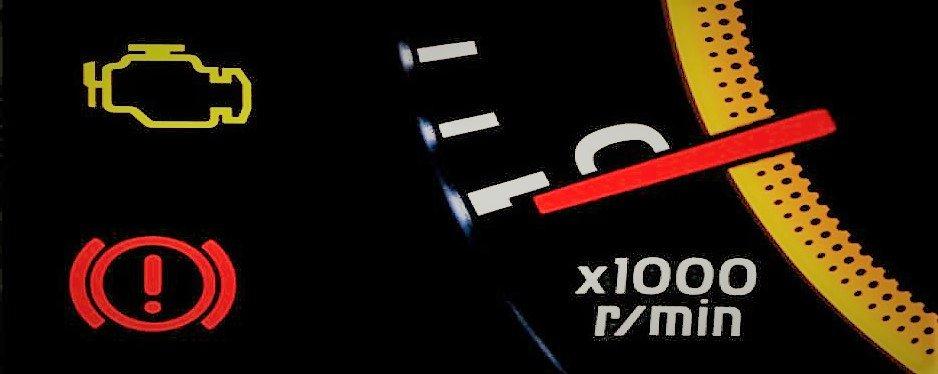
The engine management light (sometimes called the check engine light) has been a common and essential fixture in cars for a long time. It’s a dashboard warning light usually found close to your car’s speedometer dial – clearly within your line of sight – and shows up either as the outline of an engine or, simply, the words “CHECK ENGINE”. If you see it, it means that something to do with your car’s engine and/or exhaust has gone wrong.
Unfortunately, the engine management light does not warn about one specific problem. Instead, it is connected to the engine control unit (ECU): your car’s computer brain. Should the ECU detect something out of the ordinary, it will turn the light on. Depending on the problem, the engine management light can be orange, red or flashing on and off.
Depending on what causes it, there are a number of ways to get your engine management light to turn off again. Many of these can be spotted by OBD-II diagnostic scanners (more on them below…), or by taking your car to your local garage, while a few can be easily resolved on your own.
Help me pick my next carFor everything you need to know about your engine management light, read on:
Without checking, it’s almost impossible to be absolutely sure why your engine management light has come on. However, each individual problem that can cause it to light up has its own unique error code. When your engine management light illuminates, you can discover the error code of what’s gone wrong by using something called a diagnostic reader.
Diagnostic readers are commonplace in garages and can detect what’s activated your engine management light. You can also buy one in some leading technology stores, as well as online. The most common are called OBD-II scanners, which – if you own a newer model – plug into a data port in your car. They then use Bluetooth connectivity to send the corresponding error code to an app on your smartphone. Once you have the correct code, you can use online manuals or search engines to find out what it means. Some diagnostic readers even have the ability to turn your engine management light off again once you’ve been able to fix the fault.
For the most part, diagnostic readers are universal, which means they can be used on almost every new car in the UK. There are some exceptions though, as manufacturers – including Audi and Volkswagen – have their own additional error codes, specific to their models, that can only be identified by some specialised scanners.
In the long run, a diagnostic reader could prove a worthwhile investment, especially if your engine management light comes on to warn you of something that can be very easily fixed (such as a loose fuel filler cap or clogged air filter). A small, simple, handheld scanner can cost anywhere between £35 and £70, while larger and more in-depth units can have price tags that go all the way into the thousands.
If you don’t have a diagnostic reader, a rough indication of what’s gone wrong – and what to do next – is the colour of the light. Here’s a quick look at the three possibilities:
An orange or amber light is the least serious. If this light comes on and persists, it means that you should be able to keep driving as normal, but take your car to be serviced as soon as you can.
A flashing orange light means that there is a problem that could affect how the car drives or handles, such as an engine misfire. You might be able to feel your car shake, or the engine could suddenly sound different. If this light comes on, you should take your car to be serviced immediately.
A red engine management light means that there is a very serious problem. If you see this, you should stop at the nearest safe place and call your breakdown provider straight away.
Here are some of the most common problems that could cause your engine management light to turn on:

A diesel particulate filter (DPF) is fitted to diesel-powered cars in order to trap soot from the exhaust and reduce your emissions. It is possible for it to become blocked and subsequently cause your engine management light to turn on, but no need to worry! This problem should be fixed if you drive somewhere with a faster speed limit (the RAC says that a thirty-to-fifty-minute jaunt at sustained speed on the motorway should clear the filter). If that still doesn’t work, then you should take your car for servicing.
Oxygen sensors are another measure manufacturers use to reduce their cars’ emissions, measuring how much unburnt oxygen passes through the exhaust. This indicates whether or not an engine is burning too little or too much fuel and, if the sensors find a problem, can set off the engine management light. Take your car to be serviced if this is the case.
If you’re in a petrol car, problems with your spark plugs (which transfer electricity from your car’s ignition to the engine when you turn it on) can set off your engine warning light. To fix this, take your car to be serviced, where one or more spark plugs will probably be replaced.
If your fuel filler cap is loose or missing, it can set off your engine management light. This is because a loose cap can cause vapour loss, where fuel evaporates and subsequently escapes from the car. This reduces your fuel efficiency and can also be a safety risk.
Luckily, a loose fuel cap is an easy fix. Just reattach it properly and the engine management light should turn after you’ve been on the road for a short while.
Running out of transmission fluid is a problem that can result in tricky gear shifts, gear slippage, overheating and/or your engine management light turning on. Topping up your car’s levels of transmission fluid should get the job done and make the light turn off fairly quickly.
Fuel pumps filter out harmful particulates from the fuel in your car, stopping it from entering the engine and potentially causing major damage. Over time, it’s easy for the pump to become clogged or dirty, to the point where it doesn’t do its job properly. This is a serious issue, with the potential to not only turn the engine management light on, but also briefly cut the engine when you’re driving at high speeds.
If your fuel pump is blocked, you should take your car to be serviced as soon as you can.
If you own an older model, it may well rely on vacuum hoses. These channel air and some emissions around the engine so that it can run properly and efficiently. They’re common in cars from the ‘90s and 2000s, but aren’t so popular now because they proved to be unreliable. If even one of your vacuum hoses leaks, it can set off the engine management light. To fix the problem, simply take your car to a garage, where they will replace the hose that is leaking.
The catalytic converter is responsible for reducing harmful emissions made by your car. It transforms toxic carbon monoxide and nitrogen oxide gases into a mix of CO2, nitrogen and water. Problems like unburned fuel leaking and/or a leaky exhaust valve can damage or even break your catalytic converter, which will subsequently activate your engine management light.
A damaged catalytic converter is a major problem, proving environmentally unsafe and potentially very expensive. If this happens, take your car to be serviced as soon as you can.
If you’ve been able to fix what’s caused the engine management light to switch itself on in the first place, there are a number of ways to get it to turn off again. Most of the time, it should reset itself once you’ve restarted the engine. Failing that – if you have a new car – your diagnostic code reader might be able to do it. Meanwhile, older models should have a section in their manuals on how to reset the engine management light.
If you want to turn your engine management light off without fixing the problem that has caused it, you’re out of luck! Sadly, the light will just come back the next time you turn the engine on.
If your engine management light comes or remains on during an MOT, then it is classed as a major fault. After all, if the light is on, there’s a very good chance your car is either unsafe or nowhere near as clean as it should be.
Long story short: an illuminated engine management light is an instant MOT fail.
If your ECU has detected a very serious problem, then not only will your engine management light go off; your car will likely enter Limp Home Mode, too. This is a failsafe fitted into most cars to try and stop your engine and/or gearbox from totally packing in as you’re driving.
It should be easy to tell when your car has entered Limp Home Mode. Not only will the engine management light be illuminated, but you’ll also notice considerable changes in how your car feels on the road. Acceleration will be more sluggish, your top speed will be limited to somewhere between 35 and 45mph, and your engine will be restricted to less than 3,000 revs per minute.
Bookmark the carwow blog page for regular guides, news and advice.